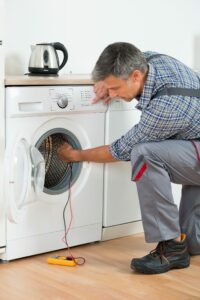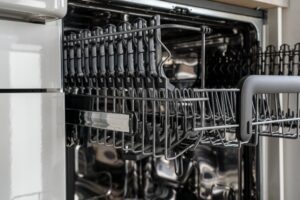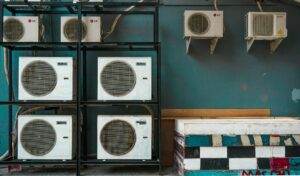Multimeters are versatile electronic devices used to measure various electrical parameters such as voltage, current, resistance, capacitance, and continuity. They are essential tools for testing and maintaining household appliances. Multimeters come in different types, including analog and digital multimeters. Analog multimeters use a needle to display readings, while digital multimeters have a digital display.
The importance of multimeters in appliance testing and maintenance cannot be overstated. They allow technicians to accurately measure electrical parameters in appliances, helping them diagnose problems and perform necessary repairs. Multimeters are used in a wide range of applications, from testing the voltage and current in appliances to checking resistance in electrical components. They are also used to measure capacitance, troubleshoot faulty appliances, diagnose electrical problems, check continuity in appliance wiring, test batteries, and calibrate appliances for accurate performance.
Key Takeaways
- Multimeters are versatile tools used to measure voltage, current, resistance, capacitance, and continuity in appliances.
- Testing voltage and current in household appliances can help identify issues with power supply and electrical components.
- Checking resistance in electrical components of appliances can help diagnose issues with heating elements, motors, and other components.
- Measuring capacitance in appliances can help optimize performance and prevent damage to sensitive components.
- Troubleshooting faulty appliances with multimeters involves diagnosing electrical problems, checking continuity in wiring, testing batteries, and calibrating for accurate performance while following safety precautions.
Testing Voltage and Current in Household Appliances
Understanding voltage and current is crucial when testing household appliances. Voltage refers to the electrical potential difference between two points in a circuit, while current is the flow of electric charge through a conductor. Testing voltage and current in appliances helps technicians determine if they are operating within the specified range.
To test voltage in an appliance, the technician needs to set the multimeter to the appropriate voltage range and connect the probes to the circuit or component being tested. The multimeter will then display the voltage reading. Similarly, to test current, the technician needs to set the multimeter to the appropriate current range and connect it in series with the circuit being tested. The multimeter will measure the current flowing through the circuit.
Testing voltage and current in appliances is important for several reasons. It allows technicians to ensure that appliances are receiving the correct voltage and that they are not drawing excessive current, which could lead to overheating or damage. It also helps identify any issues with power supply or faulty components that may be causing the appliance to malfunction.
Checking Resistance in Electrical Components of Appliances
Resistance is the opposition to the flow of electric current in a circuit. It is an important parameter to measure when testing appliances, as it helps identify faulty components or connections. Checking resistance in electrical components can help technicians pinpoint the source of a problem and determine if a component needs to be replaced.
To check resistance in appliances, the technician needs to set the multimeter to the resistance mode and connect the probes to the component being tested. The multimeter will display the resistance reading. It is important to note that resistance measurements should be performed with the power disconnected from the appliance to avoid any potential hazards.
Checking resistance in appliances is crucial because it helps identify faulty components such as resistors, capacitors, or wiring connections. High resistance readings may indicate a loose or corroded connection, while low resistance readings may indicate a short circuit. By identifying and replacing faulty components, technicians can restore the proper functioning of appliances.
Measuring Capacitance in Appliances for Optimal Performance
Capacitance is a measure of an object’s ability to store an electric charge. It is an important parameter to measure in appliances that use capacitors, such as air conditioners, refrigerators, and televisions. Measuring capacitance helps technicians ensure that capacitors are functioning properly and are within their specified range.
To measure capacitance in appliances, the technician needs to set the multimeter to the capacitance mode and connect the probes to the capacitor being tested. The multimeter will display the capacitance reading. It is important to discharge the capacitor before measuring capacitance to avoid any potential electrical shock.
Measuring capacitance in appliances is important because it helps technicians identify faulty capacitors that may be causing issues such as motor failure or improper functioning of electronic circuits. By replacing faulty capacitors, technicians can ensure optimal performance and extend the lifespan of appliances.
Troubleshooting Faulty Appliances with Multimeters
Appliances can develop various problems over time, ranging from simple issues like a blown fuse to more complex problems like a faulty motor or control board. Troubleshooting faulty appliances with multimeters is an effective way to identify the source of the problem and determine the necessary repairs.
Common appliance problems include no power, intermittent power, overheating, abnormal noises, and failure to start or operate. To troubleshoot these problems, technicians can use multimeters to test various electrical parameters such as voltage, current, resistance, and capacitance.
For example, if an appliance is not receiving power, the technician can use a multimeter to test the voltage at the power outlet and check for any loose connections or blown fuses. If an appliance is overheating, the technician can use a multimeter to measure the current draw and check for any excessive resistance in the circuit.
Troubleshooting faulty appliances with multimeters is important because it helps technicians identify the root cause of the problem and perform targeted repairs. By accurately diagnosing and fixing the issue, technicians can save time and money for both themselves and the appliance owners.
Diagnosing Electrical Problems in Appliances with Multimeters
Electrical problems are common in appliances and can cause them to malfunction or stop working altogether. Diagnosing electrical problems in appliances with multimeters is an effective way to identify the source of the problem and determine the necessary repairs.
Common electrical problems in appliances include short circuits, open circuits, faulty switches or relays, and damaged wiring. To diagnose these problems, technicians can use multimeters to test various electrical parameters such as voltage, current, resistance, and continuity.
For example, if an appliance is not turning on, the technician can use a multimeter to test for voltage at different points in the circuit and check for any open circuits or faulty switches. If an appliance is experiencing intermittent power, the technician can use a multimeter to measure the continuity of the wiring and check for any loose connections.
Diagnosing electrical problems in appliances with multimeters is important because it helps technicians identify the specific electrical issue and perform targeted repairs. By accurately diagnosing and fixing the problem, technicians can ensure the proper functioning of appliances and prevent further damage.
Checking Continuity in Appliance Wiring with Multimeters
Continuity refers to the uninterrupted flow of electric current in a circuit. Checking continuity in appliance wiring with multimeters is an effective way to ensure that all connections are intact and there are no breaks or open circuits.
To check continuity in appliance wiring, the technician needs to set the multimeter to the continuity mode and connect the probes to different points in the circuit being tested. If there is continuity, the multimeter will emit a beep or display a reading indicating that the circuit is complete. If there is no continuity, it means there is a break or open circuit in the wiring.
Checking continuity in appliance wiring is important because it helps technicians identify any breaks or open circuits that may be causing issues such as intermittent power or failure to operate. By identifying and repairing these issues, technicians can ensure the proper functioning of appliances.
Testing Batteries in Appliances with Multimeters
Batteries are commonly used in appliances such as remote controls, flashlights, and portable devices. Testing batteries with multimeters is an effective way to determine their voltage and overall health.
To test batteries in appliances, the technician needs to set the multimeter to the appropriate voltage range and connect the probes to the battery terminals. The multimeter will display the voltage reading, indicating whether the battery has sufficient charge or needs to be replaced.
Testing batteries in appliances is important because it helps technicians determine if a battery is still usable or if it needs to be replaced. By ensuring that appliances have properly functioning batteries, technicians can prevent issues such as power failure or malfunctioning of electronic circuits.
Calibrating Appliances with Multimeters for Accurate Performance
Calibrating appliances with multimeters is an important step in ensuring their accurate performance. Calibration involves adjusting the settings or parameters of an appliance to match a known standard or reference.
To calibrate appliances with multimeters, the technician needs to compare the readings obtained from the appliance to a known standard or reference. If there are any discrepancies, the technician can adjust the settings or parameters of the appliance to bring it into alignment with the standard.
Calibrating appliances with multimeters is important because it helps ensure that they are operating within the specified range and providing accurate measurements or outputs. By calibrating appliances, technicians can improve their performance and reliability.
Multimeter Safety Precautions for Appliance Testing and Maintenance
When using multimeters for appliance testing and maintenance, it is important to follow safety precautions to prevent accidents or injuries. Here are some common safety precautions to keep in mind:
1. Always wear appropriate personal protective equipment (PPE) such as gloves and safety glasses when working with electrical appliances.
2. Ensure that the appliance is disconnected from the power source before performing any tests or repairs.
3. Use insulated probes and leads when making measurements to avoid electrical shock.
4. Avoid touching exposed wires or components while the appliance is connected to power.
5. Keep the multimeter away from water or other liquids to prevent damage or electrical hazards.
6. Read and follow the manufacturer’s instructions for both the multimeter and the appliance being tested.
7. If you are unsure about how to use a multimeter or perform a specific test, consult a qualified technician or electrician.
By following these safety precautions, technicians can ensure their own safety and prevent any damage to themselves or the appliances they are working on.
Multimeters are essential tools for testing and maintaining household appliances. They allow technicians to accurately measure various electrical parameters such as voltage, current, resistance, capacitance, and continuity. By testing voltage and current, checking resistance, measuring capacitance, troubleshooting faulty appliances, diagnosing electrical problems, checking continuity, testing batteries, and calibrating appliances with multimeters, technicians can ensure the proper functioning and optimal performance of appliances.
When using multimeters for appliance testing and maintenance, it is important to follow safety precautions to prevent accidents or injuries. Wearing appropriate personal protective equipment (PPE), disconnecting the appliance from the power source, using insulated probes and leads, and avoiding contact with exposed wires are some of the common safety precautions to keep in mind.
In conclusion, multimeters are invaluable tools for technicians working on household appliances. They provide accurate measurements and help diagnose and repair various electrical issues. By using multimeters properly and following safety precautions, technicians can ensure the proper functioning and longevity of appliances.
What are some specific appliances that can be tested with a multimeter?
When conducting a multimeter testing appliances tutorial, specific appliances that can be checked include refrigerators, washing machines, and ovens. By using a multimeter, you can measure voltage, current, and resistance to ensure that these essential household appliances are functioning properly.
FAQs
What is a multimeter?
A multimeter is an electronic measuring instrument that combines several measurement functions in one unit. It can measure voltage, current, and resistance.
What are the applications of a multimeter?
A multimeter can be used in a variety of applications, including testing electrical circuits, troubleshooting appliances, and measuring the voltage of batteries.
What are some examples of multimeter applications for appliances?
Multimeters can be used to test the continuity of heating elements in appliances such as ovens and dryers, measure the voltage of batteries in appliances such as cordless drills and flashlights, and test the resistance of motors in appliances such as refrigerators and air conditioners.
How do you use a multimeter to test an appliance?
To test an appliance with a multimeter, you need to first identify the component you want to test. Then, set the multimeter to the appropriate measurement function and range. Finally, connect the multimeter leads to the component and read the measurement on the multimeter display.
What precautions should be taken when using a multimeter?
When using a multimeter, it is important to follow safety precautions such as wearing protective gear, avoiding contact with live circuits, and using the correct measurement function and range. It is also important to read the manufacturer’s instructions and follow proper procedures for handling and storing the multimeter.



